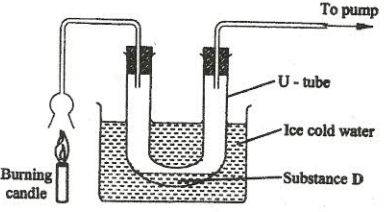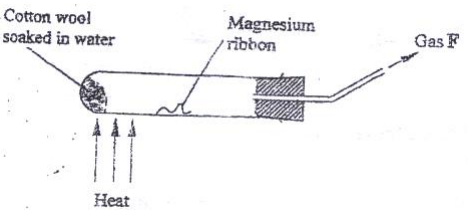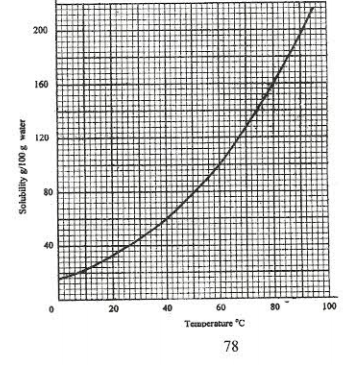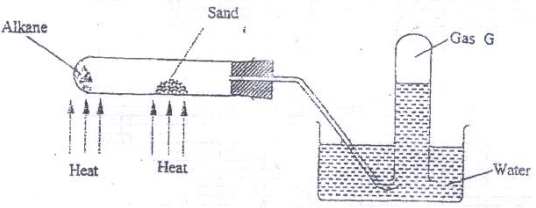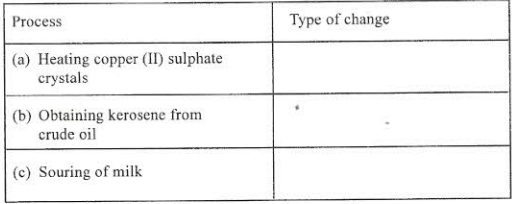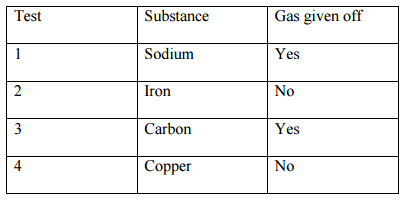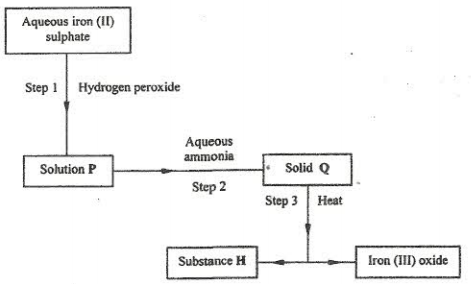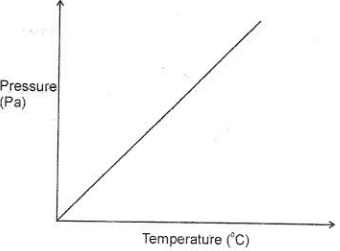- The ionization energies of three elements A, B and C are shown in the table below:
Element A B C Ionisation energy(kJ/mole) 519 418 494 - What is meant by ionization energy? (1 mark)
- Which is the strongest reducing agent? Give a reason. (2 marks)
- Hardness of water may be removed by either boiling or addition of chemicals.
-
Write an equation to show how boiling removes hardness of water. (2 marks)
-
Name two chemicals that are used to remove hardness of water. (2 marks)
-
- The atomic number of sulphur is 16.
Write the electron arrangement of sulphur in the following. (2 marks)- H2S
- SO32-
- An experiment was set up as shown in the diagram below:
- Identify substance D. (1 mark)
- Describe the other product of the burning candle that could be prevented from getting into the environment. (2 marks)
- In terms of structure and bonding, explain why the melting point of oxygen is much lower than that of sodium. (3 marks)
- An isotope of element E has 34 neutrons and its mass number is 64. E forms a cation with 28 electrons. Write the formula of the cation indicating the mass and atomic numbers. (1 mark)
- When aluminium oxide was electrolysed, 1800kg of aluminium metal were obtained.
- Write equation for the formation of aluminium metal. (1 mark)
- Calculate the quantity of electricity in faradays used. (Al = 27) (2 marks)
- Using dots (.) and crosses (×), show bonding in:
- The compound formed when nitrogen reacts with fluorine.
(Atomic number F = 9, N = 7); (1 mark) - Sodium oxide.
(Atomic numbers Na = 11, O = 8) (1 mark)
- The compound formed when nitrogen reacts with fluorine.
- What is meant by solar heat of solution? (1 mark)
- The lattice energy of sodium bromide and hydration energies of sodium and bromide ions are 733,406 and 335kJmol-1 respectively.
- Complete the energy cycle diagram below by inserting the values of
- Determine the molar heat of solution of solid sodium bromide. (½ marks)
- Complete the energy cycle diagram below by inserting the values of
- Hydrogen and oxygen can be obtained by electrolysis of acidified water. Using equations for the reactions at the electrodes, explain why the volume of hydrogen obtained is twice that of oxygen. (2 marks)
- Starting with 50cm3 of 2.8 M sodium hydroxide, describe how a sample of pure sodium sulphate crystals can be prepared. (3 marks)
- The standard reduction potentials of two half cells are:
Draw a labeled diagram of an electrochemical cell that can be constructed using the two half cells. (3 marks) - When 8.53g of sodium nitrate were heated in an open test tube, the mass of oxygen gas produced was 0.83 g. given the equation of the reaction as
2NaNO3(s) ---> 2NaNO2(s) + O2(g)
Calculate the percentage of sodium nitrate that was converted sodium nitrite. (Na = 23.0, N = 14.0, O = 16.0) (3 marks) - Draw and name the structure of the compound formed when one mole of ethyne reacts with one mole of hydrogen bromide. (2 marks)
- Draw the structures of the alkynes whose molecular formula is C4H6. (1 mark)
- A student used the set up shown in the diagram below in order to study the reactions of some metals with steam. The experiment was carried out for ten minutes.
- What observation would be made if gas F is ignited? (1 mark)
- When the experiment was repeated using iron powder instead of magnesium ribbon very little gas F was obtained.
- Give a reason for this observation. (1 mark)
- What change in the conditions of the experiment should the student have made in order to increase the volume of gas F produced? (1 mark)
- The solubility curve of potassium nitrate is as shown below.
- Determine the solubility of potassium nitrate at 50oC. (1 mark)
- Determine the molar concentration of saturated potassium nitrate at 50oC.
(K = 39.0, O = 16.0, N = 14.0 and density of water 1g/cm3) (2 marks)
- The structure of methanoic acid is
What is the total number of electrons used for bonding in the molecule of methanoic acid? Give reasons. (2 marks) - Bottles of sodium carbonate, sodium chloride and sugar have lost their labels. A student prepares and tests an aqueous solution of a sample from each bottle.
The results obtained are shown in the table below.
Complete the table by filling the correct label for each bottle. (3 marks) - The figure below represents the set up that was used to crack an alkane.
- What is the purpose of the sand? (1 mark)
- After sometime, a colourless gas G collected in the test-tube.
Describe the chemical test and the observations that would be made in order to identify the class of compounds to which gas G belongs. (2 marks)
- Classify the following processes as either chemical or physical. (3 marks)
- Give the name of the product formed when magnesium reacts with phosphorous. (1 mark)
- A student added very dilute sulphuric (VI) acid to four substances and recorded the observations shown in the table below.
For which tests are the observations wrong? Explain. (3 marks) - Use the flow chart below to answer the questions that follow.
- What observation would be made in step I? (1 mark)
- Name the other substance that could be used in step 2. (1 mark)
- Give the name of substance H. (1 mark)
- The boiling points of some compounds of hydrogen with some elements in groups 4 and 6 of the periodic table are given below.
Compound Boiling point (oC) Compound Boiling point (oc) CH4 -164.0 H2O 100.0 SiH4 -112.0 H2S -61.0 - Which of the compounds CH4 and SiH4 has the stronger intermolecular forces?
Give a reason. (2 marks) - Explain why the boiling points of H2O and H2S shows different trends from that of CH4 and SiH4. (2 marks)
- Which of the compounds CH4 and SiH4 has the stronger intermolecular forces?
- For each of the following reactions, state the observations and write the formula of the compound responsible for the observation:
- bromide water is added to aqueous potassium iodide; (1½ marks)
- Excess aqueous ammonia is added to copper (II) hydroxide (precipitate). (1½ marks)
- The graph below shows the relationship between pressure and the temperature of a gas fixed volume container.
- State the relationship between pressure and temperature that can be deduced from the graph. (1 mark)
- Using kinetic theory, explain the relationship shown in the graph. (2 marks)
- The following reaction is an equilibrium in a closed container.
State giving the reason how an increase in pressure would affect the amount of hydrogen. (2 marks) - The energy level diagram below shows the effect of a catalyst on the reaction path.
- What does point M represent? (1 mark)
- With reference to the energy level diagram, explain how a catalyst increases the rate of a reaction. (2 marks)
- Draw the structure of compound N formed in the following reaction (1 mark)
- Give one use of compound N. (1 mark)
- Draw the structure of compound N formed in the following reaction (1 mark)
Download Kenya Certificate Of Secondary Education (KCSE 2009) Chemistry Paper 1.
Tap Here to Download for 50/-
Get on WhatsApp for 50/-
Why download?
- ✔ To read offline at any time.
- ✔ To Print at your convenience
- ✔ Share Easily with Friends / Students

